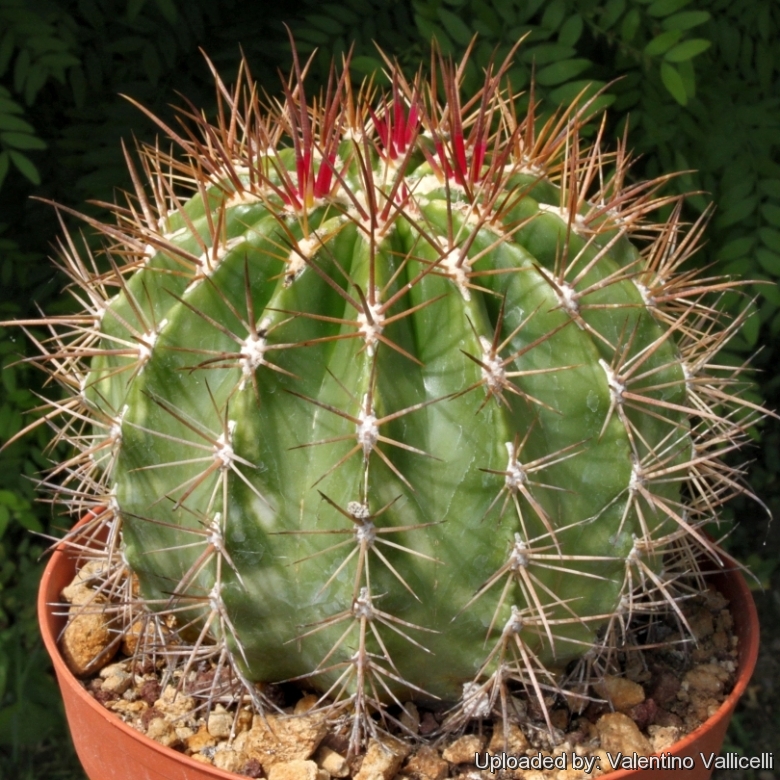
Ferocactus lindsayi Photo by: Valentino Vallicelli
This is the last discovered species of Ferocactus found only on 1964. It is of extremely slow growth, hence very rare in cultivation and highly prized by collectors.
Origin and Habitat: Mexico. Endemic to a restricted area in the lower part of the river Balsas between Michoacan and Guerrero. Around the hydroelectric dam of Infernillo.
Synonyms:
Description: Solitary and very slow growing species.
Stem: At first globular then semi-cylindrical, 40 cm diameter, 60 cm tall. Epidermis is grey-green or purple-bluish (in full sun).
Spines: Young spines at the plant apex are red or yellow. But all the spines as they ages become grey with a darker tip (almost black).
Radial spines: 7-8.
Central spines: 1 stronger and straight.
Flowers: Pale yellow
Remarks: In cultivation it is possible to find two distinct form called "RED FORM" and "YELLOW FORM". The yellow type form has yellow young spines and it is also greener in colour, while the red form (with red young spines) tend to have a redder epidermis (especially in winter). This 2 forms are not cultivars but simply selected plants raised from controlled pollination from naturally yellow and red specimens. Natural populations comprises a mix of red, yellow and intermediate spines colours.
Bibliography: Major references and further lectures
1) Edward Anderson “The Cactus family” Timber Press, Incorporated, 2001
2) James Cullen, Sabina G. Knees, H. Suzanne Cubey "The European Garden Flora Flowering Plants: A Manual for the Identification of Plants Cultivated in Europe, Both Out-of-Doors and Under Glass" Cambridge University Press, 11/Aug/2011
3) David R Hunt; Nigel P Taylor; Graham Charles; International Cactaceae Systematics Group. "The New Cactus Lexicon" dh books, 2006
4) Urs Eggli, Leonard E. Newton “Etymological Dictionary of Succulent Plant Names” Birkhäuser 2004.
 Ferocactus lindsayi Photo by: Raimondo Paladini
Ferocactus lindsayi Photo by: Raimondo Paladini Ferocactus lindsayi Photo by: Valentino Vallicelli
Ferocactus lindsayi Photo by: Valentino Vallicelli Ferocactus lindsayi Photo by: Valentino Vallicelli
Ferocactus lindsayi Photo by: Valentino Vallicelli Yellow-brown spines form (This variant has yellow to pale-brown new spines and greener stems) Photo by: Cactus Art
Yellow-brown spines form (This variant has yellow to pale-brown new spines and greener stems) Photo by: Cactus Art Ferocactus lindsayi Photo by: Valentino Vallicelli
Ferocactus lindsayi Photo by: Valentino Vallicelli Ferocactus lindsayi Photo by: Valentino Vallicelli
Ferocactus lindsayi Photo by: Valentino Vallicelli Ferocactus lindsayi Photo by: Valentino Vallicelli
Ferocactus lindsayi Photo by: Valentino Vallicelli A young specimen at the end of the winter rest. Photo by: Valentino Vallicelli
A young specimen at the end of the winter rest. Photo by: Valentino VallicelliCultivation and Propagation: Very slow growing. Use very draining soil, water during the aestival growth cycle (this plant needs regular water) But it is necessary to avoid wetting the bodies of these plants while they are in sunlight. A wet cactus in the sun light can cause sun burning, which can lead to scars, or even fungal infections and death.
Needs full sun. Keep dry at 10°C in winter, but it can tolerate sporadic light frost.
Propagation: Seeds are the only way of reproducing.
Your Photos
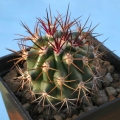
by Valentino Vallicelli
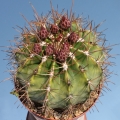
by Valentino Vallicelli
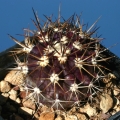
by Valentino Vallicelli
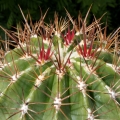
by Valentino Vallicelli
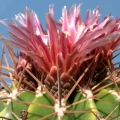
by Valentino Vallicelli























